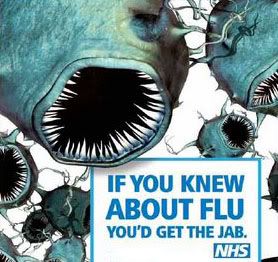
And it was real relief - visiting various workplaces, I've met some very tense people who would not need an especially hard shove to tip them over into panic.

The stampede of folk who sought to have themselves diagnosed (or otherwise) with swine flu that crashed the new Government website, for example, smacks of panic; in April, a newspaper forecast 20,000 deaths in the southern English county of Hampshire (population 1.75 million); and Professor Steve Field, chairman

of the Royal College of General Practitioners, has accused the National Childbirth Trust, in its instructions to woman who want families to try not to conceive at the moment, of "a completely disproportionate reaction...because it adds to the sense of hysteria and panic that seems to be engulfing the nation".
The Telegraph's Jon Swaine reports that the Government has had to deny giving mixed messages to pregnant women, as it originally (wisely) told them not to travel on, say, London's tube at rush-hour, then said that good hand hygeine is sufficient.
I wouldn't wish to minismise the importance of handwashing - the RCGP's Pandemic Planning document states "The good news is that flu viruses are easily deactivated by washing with soap and water or alcohol handrub and by cleaning surfaces with normal household detergents and cleaners" (my italics). But Cambridge University, like others, is taking the eminently sensible step of formulating a "swine flu action plan" should the beastie get bad around the time of the next intake, having learnt from the phenomenon of "fresher flu" (not to mention fresher mumps, glandular fever and sexually transmitted diseases). Likewise, it was reassuring to see that the city's Addenbrooke's hospital is remaining calm in the face of mounting dissatisfaction.
When this outbreak was beginning, something that might have helped could have been a strategy which, although now frowned on, saved many of us over a certain age from the more serious consequences of catching childhood diseases in adulthood - the "chickenpox party" (or measles party, mumps party, etc). That wouldn't be a very clever thing to do now though, because the virus has changed already.
So what's the problem?
The problem is twofold. Firstly, overprescription of Tamiflu, a medication manufactured by Roche that is said to take the edge off the illness and sometimes even shorten its duration. Two years ago, Swedish researchers found that not all oseltamivir, the active ingedient of Tamiflu, is broken down in the body: some passes into the sewage system, thence the water supply, unchanged. The researchers concluded that "there is a risk that [antiviral medications such as Tamiflu] will be ineffective when most needed, such as during the next influenza pandemic". In June, mutated swine flu was detected in Brazil; early in July, a strain of Tamiflu-resistant flu was reported in a teenager in Hong Kong who hadn't taken the drug, and later in the month another mutation was found in London: all responding, no doubt, to evolutionary pressure exerted by the inappropriate administration of anti-flu medication.

Secondly, at the recommendation of the World Health Organisation, we used to have a policy of vaccinating vulnerable groups against ("ordinary") influenza - older people, children with illnesses like diabetes, people who are immunocompromised, etc. Some years ago, the Government changed this to a manipulative campaign pushing flu vaccination to just about everybody, and this was backed up with documentaries detailing the attritions of the so-called Spanish Flu of 1918 and the chances of another pandemic. The intended effect of mild hysteria provided perfect fodder for the incipient panic we are now seeing.
We do need to keep a sense of perspective, however. For example, over here in Blighty, thirty-one people are said to have died of the flu, but the figure is constantly being revised as people are found to have died alongside their flu from a third cause. Case in point: poor six-year-old Chloe Buckley had swine-flu, but actually died from toxic shock as a result of a tonsillectomy. The World Health Organization's table charting the progress of Influenza A(H1N1) - swine flu - shows, as of the end of June, 2,506 cases diagnosed, and precisely one death confirmed by laboratory analysis. (21,449 and 87 respectively in the US, which of course borders on Mexico, the country of origin.)
The title of the Telegraph's editorial captures it exactly, quoting an undistributed WWII poster that would have been published had the Germans invaded: Keep calm and carry on. Or, as a wise old boss of mine once said: "Don't worry - when it's time to panic, I'll tell you to panic."

related posts
Swine flu and the hazard of hysteria
Happy birthday Charles Darwin











No comments:
Post a Comment
Please feel free to leave a comment - Frugal Dougal.